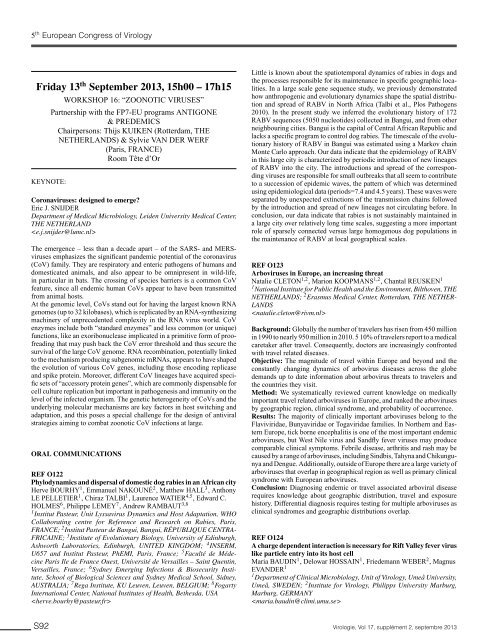rologie i - European Congress of Virology
rologie i - European Congress of Virology
rologie i - European Congress of Virology
You also want an ePaper? Increase the reach of your titles
YUMPU automatically turns print PDFs into web optimized ePapers that Google loves.
5 th <strong>European</strong> <strong>Congress</strong> <strong>of</strong> <strong>Virology</strong>Friday 13 th September 2013, 15h00 – 17h15KEYNOTE:WORKSHOP 16: “ZOONOTIC VIRUSES”Partnership with the FP7-EU programs ANTIGONE& PREDEMICSChairpersons: Thijs KUIKEN (Rotterdam, THENETHERLANDS) & Sylvie VAN DER WERF(Paris, FRANCE)Room Tête d’OrCoronaviruses: designed to emerge?Eric J. SNIJDERDepartment <strong>of</strong> Medical Microbiology, Leiden University Medical Center,THE NETHERLANDThe emergence – less than a decade apart – <strong>of</strong> the SARS- and MERSvirusesemphasizes the significant pandemic potential <strong>of</strong> the coronavirus(CoV) family. They are respiratory and enteric pathogens <strong>of</strong> humans anddomesticated animals, and also appear to be omnipresent in wild-life,in particular in bats. The crossing <strong>of</strong> species barriers is a common CoVfeature, since all endemic human CoVs appear to have been transmittedfrom animal hosts.At the genomic level, CoVs stand out for having the largest known RNAgenomes (up to 32 kilobases), which is replicated by an RNA-synthesizingmachinery <strong>of</strong> unprecedented complexity in the RNA virus world. CoVenzymes include both “standard enzymes” and less common (or unique)functions, like an exoribonuclease implicated in a primitive form <strong>of</strong> pro<strong>of</strong>readingthat may push back the CoV error threshold and thus secure thesurvival <strong>of</strong> the large CoV genome. RNA recombination, potentially linkedto the mechanism producing subgenomic mRNAs, appears to have shapedthe evolution <strong>of</strong> various CoV genes, including those encoding replicaseand spike protein. Moreover, different CoV lineages have acquired specificsets <strong>of</strong> “accessory protein genes”, which are commonly dispensable forcell culture replication but important in pathogenesis and immunity on thelevel <strong>of</strong> the infected organism. The genetic heterogeneity <strong>of</strong> CoVs and theunderlying molecular mechanisms are key factors in host switching andadaptation, and this poses a special challenge for the design <strong>of</strong> antiviralstrategies aiming to combat zoonotic CoV infections at large.ORAL COMMUNICATIONSREF O122Phylodynamics and dispersal <strong>of</strong> domestic dog rabies in an African cityHerve BOURHY 1 , Emmanuel NAKOUNÉ 2 , Matthew HALL 3 , AnthonyLE PELLETIER 1 , Chiraz TALBI 1 , Laurence WATIER 4,5 , Edward C.HOLMES 6 , Philippe LEMEY 7 , Andrew RAMBAUT 3,81 Institut Pasteur, Unit Lyssavirus Dynamics and Host Adaptation, WHOCollaborating centre for Reference and Research on Rabies, Paris,FRANCE; 2 Institut Pasteur de Bangui, Bangui, RÉPUBLIQUE CENTRA-FRICAINE; 3 Institute <strong>of</strong> Evolutionary Biology, University <strong>of</strong> Edinburgh,Ashworth Laboratories, Edinburgh, UNITED KINGDOM; 4 INSERM,U657 and Institut Pasteur, PhEMI, Paris, France; 5 Faculté de MédecineParis Ile de France Ouest, Université de Versailles – Saint Quentin,Versailles, France; 6 Sydney Emerging Infections & Biosecurity Institute,School <strong>of</strong> Biological Sciences and Sydney Medical School, Sidney,AUSTRALIA; 7 Rega Institute, KU Leuven, Leuven, BELGIUM; 8 FogartyInternational Center, National Institutes <strong>of</strong> Health, Bethesda, USALittle is known about the spatiotemporal dynamics <strong>of</strong> rabies in dogs andthe processes responsible for its maintenance in specific geographic localities.In a large scale gene sequence study, we previously demonstratedhow anthropogenic and evolutionary dynamics shape the spatial distributionand spread <strong>of</strong> RABV in North Africa (Talbi et al., Plos Pathogens2010). In the present study we inferred the evolutionary history <strong>of</strong> 172RABV sequences (5050 nucleotides) collected in Bangui, and from otherneighbouring cities. Bangui is the capital <strong>of</strong> Central African Republic andlacks a specific program to control dog rabies. The timescale <strong>of</strong> the evolutionaryhistory <strong>of</strong> RABV in Bangui was estimated using a Markov chainMonte Carlo approach. Our data indicate that the epidemiology <strong>of</strong> RABVin this large city is characterized by periodic introduction <strong>of</strong> new lineages<strong>of</strong> RABV into the city. The introductions and spread <strong>of</strong> the correspondingviruses are responsible for small outbreaks that all seem to contributeto a succession <strong>of</strong> epidemic waves, the pattern <strong>of</strong> which was determinedusing epidemiological data (periods=7.4 and 4.5 years). These waves wereseparated by unexpected extinctions <strong>of</strong> the transmission chains followedby the introduction and spread <strong>of</strong> new lineages not circulating before. Inconclusion, our data indicate that rabies is not sustainably maintained ina large city over relatively long time scales, suggesting a more importantrole <strong>of</strong> sparsely connected versus large homogenous dog populations inthe maintenance <strong>of</strong> RABV at local geographical scales.REF O123Arboviruses in Europe, an increasing threatNatalie CLETON 1,2 , Marion KOOPMANS 1,2 , Chantal REUSKEN 11 National Institute for Public Health and the Environment, Bilthoven, THENETHERLANDS; 2 Erasmus Medical Center, Rotterdam, THE NETHER-LANDSBackground: Globally the number <strong>of</strong> travelers has risen from 450 millionin 1990 to nearly 950 million in 2010. 5 10% <strong>of</strong> travelers report to a medicalcaretaker after travel. Consequently, doctors are increasingly confrontedwith travel related diseases.Objective: The magnitude <strong>of</strong> travel within Europe and beyond and theconstantly changing dynamics <strong>of</strong> arbovirus diseases across the globedemands up to date information about arbovirus threats to travelers andthe countries they visit.Method: We systematically reviewed current knowledge on medicallyimportant travel related arboviruses in Europe, and ranked the arbovirusesby geographic region, clinical syndrome, and probability <strong>of</strong> occurrence.Results: The majority <strong>of</strong> clinically important arboviruses belong to theFlaviviridae, Bunyaviridae or Togaviridae families. In Northern and EasternEurope, tick borne encephalitis is one <strong>of</strong> the most important endemicarboviruses, but West Nile virus and Sandfly fever viruses may producecomparable clinical symptoms. Febrile disease, arthritis and rash may becaused by a range <strong>of</strong> arboviruses, including Sindbis, Tahyna and Chikungunyaand Dengue. Additionally, outside <strong>of</strong> Europe there are a large variety <strong>of</strong>arboviruses that overlap in geographical region as well as primary clinicalsyndrome with <strong>European</strong> arboviruses.Conclusion: Diagnosing endemic or travel associated arboviral diseaserequires knowledge about geographic distribution, travel and exposurehistory. Differential diagnosis requires testing for multiple arboviruses asclinical syndromes and geographic distributions overlap.REF O124A charge dependent interaction is necessary for Rift Valley fever viruslike particle entry into its host cellMaria BAUDIN 1 , Delowar HOSSAIN 1 , Friedemann WEBER 2 , MagnusEVANDER 11 Department <strong>of</strong> Clinical Microbiology, Unit <strong>of</strong> <strong>Virology</strong>, Umeå University,Umeå, SWEDEN; 2 Institute for <strong>Virology</strong>, Philipps University Marburg,Marburg, GERMANYS92 Vi<strong>rologie</strong>, Vol 17, supplément 2, septembre 2013


